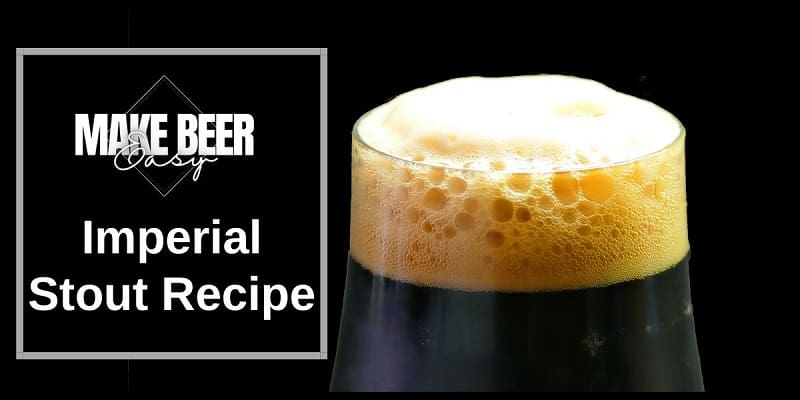Imperial stout, also known as Russian Imperial stout, was originally brewed in London for export to Russia. It was originally brewed with a higher gravity and more hops than other stouts in order to withstand the long journey to Russia and to also provide a more robust flavor that distinguishes it from many of the other stouts. The story goes that Catherine the Great and Peter the Great were both fans of this strong, dark beer, and as a result, it also became popular among the Russian nobility of the time.
The term “Russian Imperial stout” is believed to have been coined by the brewery that first exported the beer to Russia in the 18th century. It is known for its bold, roasted flavors and a full-bodied mouthfeel more so than dry stouts and porters. It is a complex and flavorful beer that pairs well with a variety of hearty foods.
In this blog post, we will provide an imperial stout recipe for brewing your own at home. We will also explore its style profile, including its appearance, aroma, mouthfeel, and taste, as well as the best food pairings, and lastly, we will provide tips on selecting the best grains, hops, and yeast for this recipe.
Imperial Stout Recipe
The following is a 5-gallon Imperial Stout Recipe you can make at home.
Original Gravity – 1.094
Final Gravity – 1.018
ABV – 9.5 – 10%
IBU – 55
SRM – 36
Ingredients:
16 lbs pale malt (Maris Otter)
1 lb crystal malt 45L
1 lb chocolate malt
1 lb roast barley
1 lb flaked oats
1 oz Galena (60 min)
1.5 oz East Kent Goldings hops (60 min)
1 oz Fuggles hops (10 min)
Irish ale yeast or Fermentis Safale US-05
Instructions:
Heat 6.5 gallons of water to 160°F and add the crushed grains. Stir the grains to ensure even steeping.
Maintain the mash temperature at 150-153°F for 60 minutes.
Mash out for 10 minutes at 170°F
Remove the grains
Bring the wort to a boil and add the Galena and East Kent Goldings hops
Boil for 50 minutes, then add the Fuggles hops.
Boil for an additional 10 minutes, then remove the pot from the heat.
Cool the wort to 70°F, then transfer it to a fermenter.
Pitch the Irish ale yeast and ferment at 65-70°F for 2-3 weeks.
Bottle or keg the beer and allow it to condition for 2-3 weeks before serving.
Style Profile
Appearance:
Imperial stout has a deep, dark color ranging from black to deep brown, with a dense, creamy head that persists over time.
Aroma:
It has a complex aroma, with scents of roasted malt, chocolate, coffee, and dark fruit. It may also have a hint of bitterness from the hops.
Mouthfeel:
It has a full-bodied mouthfeel with a smooth, creamy texture, with a moderate to high level of carbonation.
Taste:
Imperial stouts have a rich, complex flavor profile with notes of roasted malt, chocolate, coffee, and dark fruit. They have a moderate to high level of bitterness, with a balance of sweetness from the malt and hops.
Food Pairings:
They are known for pairing well with hearty, savory foods such as beef stew, roasted meats, and sharp cheeses. They also go well with sweet desserts such as chocolate cake or sticky toffee pudding.
Brewing Tips
Grains – The grains used in this imperial stout recipe provide the base for the flavor and body of the beer, while the pale malt contributes a malty sweetness and a pale color, and the crystal malt adds a hint of caramel and a reddish hue. The chocolate malt adds flavors of chocolate and coffee, while the roast barley adds a deep, roasted flavor. Lastly, the oats provide for a smooth and creamy texture.

Hops – Galena adds bitterness, as well as some earthy, spicy, and pine-like flavors. It is important not to use too much Galena as they can result in a harsh, astringent bitterness, use them in moderation and in combination with other hop varieties. East Kent Goldings provides a nice balance of bitterness and earthy, floral flavors, while Fuggles add a hint of spicy, woody flavors.
Yeast – For this imperial stout recipe, we prefer to use an Irish ale yeast as it ferments cleanly and allows the malt and hop flavors to shine through. It also has a moderate to high attenuation, which helps to dry out the beer and balance the sweetness from the malt. Other yeasts that could be used include British (English) ale yeast or American ale yeast. When choosing a yeast strain use one that will ferment well at the intended temperature range and produce the desired flavors for the style of beer.
There are many brands of yeast available on the market that make a suitable choice for brewing imperial Irish stout. Some of the more popular options include White Labs Irish Ale Yeast, Wyeast Irish Ale Yeast, and Fermentis us-05 will also work well.
Some things to consider when choosing a yeast are its attenuation level, flavor profile, and temperature range.
Last Call
Imperial stouts are strong, flavorful beers with a rich history dating back to the 18th century. Their bold, roasted flavors and full-bodied mouthfeel make it a perfect choice for those who appreciate complex and hearty beers. By following this imperial stout recipe provided in this article you can brew your own at home using a variety of grains, hops, and yeast.
Don’t be afraid to experiment with different ingredients to create your own unique take on this classic beer style. Whether enjoyed on its own or paired with savory or sweet foods, an imperial Irish stout recipe is sure to satisfy the taste buds of any beer lover.
P.S. If you want to get Big Robb’s top 5 favorite beer recipes from his brewpub be sure to pick them up on the side of the blog or at the bottom if you are on your phone. Cheers!
